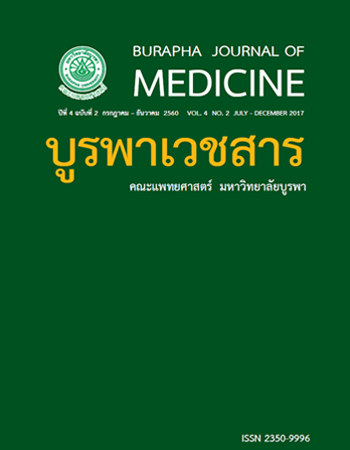อนามัยเจริญพันธุ์วัยแรงงาน
คำสำคัญ:
อาชีวเวชศาสตร์, อาชีวอนามัย, แรงงาน, เจริญพันธุ์บทคัดย่อ
ข้อมูลจากสำนักงานสถิติแห่งชาติในปี พ.ศ. 2559 พบว่า แรงงานที่มีอายุตั้งแต่ 15 ปีขึ้นไป มีจำนวนมากถึง 55 ล้านคนจากประชากรทั้งหมด 70 ล้านคน และเกินกว่ากึ่งหนึ่งมีอายุอยู่ในช่วงวัยเจริญพันธุ์ โดยเป็น เพศหญิงถึง 28 ล้านคน แต่กลับพบว่า กฎระเบียบที่ให้ความคุ้มครองแรงงานเหล่านี้ เป็นการดูแลในภาพรวมของแรงงานทั่วๆ ไปเท่านั้น โดยยังให้ความสำคัญกับผลกระทบต่อภาวะเจริญพันธุ์อันเนื่องมาจากปัจจัยการทำงานค่อนข้างน้อย แต่หากพิจารณาถึงผลการกระทบในระยะยาวแล้วจะส่งผลต่อภาพรวมของสุขภาพของประชากรในอนาคตของประเทศได้ในหลายด้าน อาทิ ความสามารถในการสืบพันธุ์ ความพิการแต่กำเนิด การแท้งบุตร การคลอดก่อนกำหนด และผลอันไม่พึงประสงค์อื่นจากการตั้งครรภ์และการคลอด ตลอดจนโรคมะเร็งในเด็ก ซึ่งประเทศไทยยังขาดข้อมูลพื้นฐานในส่วนนี้ บทความนี้เป็นการรวบรวมองค์ความรู้ในมุมมองของผลกระทบของอาชีพต่ออนามัยการเจริญพันธุ์ในภาพรวม อันเป็นกระบวนการแลกเปลี่ยนเรียนรู้ในวงการวิชาชีพและผู้สนใจให้เกิดความเข้าใจตรงกัน เพื่อพัฒนางานของตนเองในเชิงป้องกันผลเสียหายที่จะเกิดขึ้นในอนาคตต่อไป
เอกสารอ้างอิง
2. Christina C. Lawson BG, George P. Daston,Linda M Frazier, Dennis Lynch, Melissa McDiarmid, et al. Workgroup Report: implementing a National Occupational Reproductive Research Agenda--decade one and beyond. Environ Health Perspect. 2006; 114: 435-41.
3. Till C, Koren G, Rovet JF. Workplace standards for exposure to toxicants during pregnancy. Canadian Journal of Public Health. 2008; 99: 472-4.
4. Paul M. Occupational reproductive hazards.The Lancet. 1997; 349(9062): 1385-88.
5. Winker R, Rudiger HW. Reproductive toxicology in occupational settings: an update. Int Arch Occup Environ Health.2006; 79: 1-10.
6. NIOSH. The effects of workplace hazard on female reproductive health. Cincinnati,Ohio: NIOSH; 1999 [cited February 1999].Available from: http://www.cdc.gov/niosh.
7. Figa-Talamanca I. Occupational risk factors and reproductive health of women. Occup Med. 2006; 56: 521-31.
8. ACOEM TFoRT. Reproductive and developmental hazard management guidance. JOEM. 2011; 53: 941-8.
9. Server LE. Ethics, society and occupational reproductive hazards: fetal consequences?Woman & Health. 2000; 30: 25-37.
10. HESIS Hesais. Workplace chemical hazards to reproductive health. 2nd ed. Richmond,California: Hazard evaluation system and information service; 1999.
11. G o l d m a n R H . O c c u p a t i o n a l a n d environmental risks to reproduction in females 2012. [cited Aug 2017]. Available from: http://www.uptodate.com/contents/occupational-and-environmental-risks-toreproduction-in-females?source=searchres
ult&search=reproductive+health&selectedTitle=1~150.
12. Windham GC, Lee D, Mitchell P, Anderson M, Petreas M, Lasley B. Exposure to organochlorine compounds and effects on ovarian function. Epidemiology. 2005;16(2):182-90.
13. Janice F. Bell FJZ, Paula K. Diehr. Maternal work and birth outcome disparities. Maternal and Child Health Journal. 2008; 12: 415-26.
14. Tuntiseranee P, Olsen J, Chongsuvivatwong V, Limbutara S. Fecundity in Thai and European regions: results based on waiting time to pregnancy. Hum Reprod. 1998; 13:471-7.
15. Tuntiseranee P, Olsen J, Geater A, Koranantakul O. Are long working hours and shiftwork risk factors for subfecundity? A study among couples from southern Thailand. Occup Environ Med. 1998; 55:99-105.
16. Zhu JL, Hjollund NH, Boggild H, Olsen J. Shift work and subfecundity: a causal link or an artefact? Occup Environ Med. 2003; 60(9):E12.
17. Figa-Talamanca I. Reproductive problems among women health care workers:epidemiologic evidence and preventivestrategies. Epidemiol Rev. 2000;22(2):249-60.
18. Health NIOSH. The effects of workplace hazard on female reproductive health[Electronic book]. Cincinnati,OH: National Institute for Occupational Safety and Health;1999 [cited February 1999]. Available from:http://www.cdc.gov/niosh.
19. Baranski B. Effects of the workplace on fertility and related reproductive outcomes.Environ Health Perspect. 1993; 101 Suppl 2:81-90.
20. Ichihara G. Investigation of toxicity through human cases and animal experiments--study of bromopropanes. Nihon Eiseigaku Zasshi. 2005; 60: 405-10.
21. Ichihara G. Neuro-reproductive toxicities of 1-bromopropane and 2-bromopropane. Int Arch Occup Environ Health. 2005; 78: 79-96.
22. Okamura A, Kamijima M, Shibata E, Ohtani K,Takagi K, Ueyama J, et al. A comprehensive evaluation of the testicular toxicity of dichlorvos in Wistar rats. Toxicology. 2005;213: 129-37.
23. Gresie-Brusin DF, Kielkowski D, Baker A,Channa K, Rees D. Occupational exposure to ethylene oxide during pregnancy and association with adverse reproductive outcomes. Int Arch Occup Environ Health.2007; 80: 559-65.
24. Jedrychowski W, Perera F, Mroz E, Edwards S, Flak E, Bernert J, et al. Fetal exposure to second hand tobacco smoke assessed by maternal self-reports and cord blood cotinine: prospective cohort study inKrakow. Maternal and Child Health Journal.2009; 13: 415-23.
25. Yousef S. Khader NA-A, Ibrahim M. AIZubi,Isam Lataifeh. The association between second hand smoke and low birht weight and preterm delivery. Matern Child Health J. 2011; 15: 453-9.
26. Aggazzotti G, Righi E, Fantuzzi G, Biasotti B, Ravera G, Kanitz S, et al. Chlorination by-products (CBPs) in drinking water and adverse pregnancy outcomes in Italy. J Water Health. 2004; 2: 233-47.
27. Righi E, Fantuzzi G, Montanari M, Bargellini A, Predieri G, Aggazzotti G. [Exposure to water disinfection by-products and adverse pregnancy outcomes: results of a casecontrol study carried out in Modena (Italy)].Ann Ig. 2003; 15: 649-62.
28. Ong CN, Koh D, Phoon WO. Review and reappraisal of health hazards of display terminals 1988. Available from:http://www.sciencedirect.com/science?_ob=GatewayURL&_origin=ScienceSearch&_m e t h o d = c i t a t i o n S e a r c h & _
piikey=0141938288901060&_version=1&_returnURL=http%3A%2F%2Fwww.scirus.com%2Fsrsapp%2F&md5=0508acdbdcfe4c12d41540b44e12fec4.
29. Moses M. Health workers and reproductivehazards. Birth. 1987; 14: 153-5.
30. Reproductive hazards. State of the art review. Occupational Medicine. 1994; 9:363-372.
31. Winder C. Protective legislation and discrimination in employment in the Australian lead processing industry. Journal of Occupational Health and Safety Australia New Zealand. 1988; 5: 121-8.



